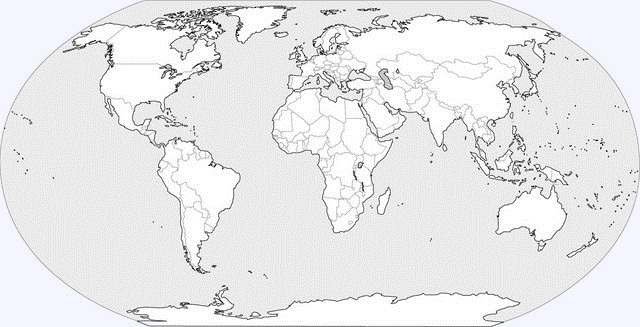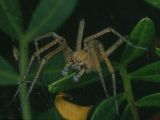|
Nombre común en ingles:
Large hammock-web spiders
Nombre común en castellano:
Se desconoce
Familias similares:
Género tipo:
Pimoa Chamberlin & Ivie, 1943
Diagnosis:
Medium to small araneomorph
spiders; ecribellate; entelegyne, eight eyes; three tarsal claws;
recognised by the presence of a retrolateral cymbial sclerite
(piramoid cymbial sclerite), a dorsoectal cymbial process, and
cuspules (modified macrosetae) on either the cymbial process or the
dorsal surface of the cymbium and a paracymbium attached to the
cymbium on the male palp and an epigyne with a scape with the
copulatory openings at the distal end.
Caracteres descriptivos:
Caparazón:
longer than wide elongate conspicuous. Esternón:
longer than wide, projecting between coxae IV. Ojos: eight
subequal, in two rows; anterior row recurved, posterior row variable
(from above); lateral eyes touching; secondary eyes with
canoe-shaped tapetum. Quelíceros: large, promargin with two
or three, retromargin with 1-4 teeth; usually with stridulating
file. Piezas bucales: endites almost retangular, parallel;
labium wider than long. Patas: 1423, longer in male than in
female; tarsi with three claws; spination variable; usually one
trichobothrium on metatarsi; autospasy at patella-tibia junction. Palpo femenino:
slender, with numerous spines: tarsal with claw provided with row of
minute denticles and basal tooth. Abdomen: oval, slightly
longer than wide. Hileras:
six, all well developed; colulus fairly large with setae; anterior
lateral spinnerets with reduced bases of piriform gland spigots;
posterior median spinnerets without aciniform gland spigots;
posterior lateral spinnerets with two cylindrical gland spigots
(base of peripheral cylindrical spigot slightly larger than base of
distal one); triplet absent in males. Sistema respiratorio:
two booklungs and tracheal spiracle just in front of spinnerets;
tracheae haplotracheate. Genitalia: entelegyne; epigyne
large with well developed scpe-like protrusion, consisting of a
dorsal and ventral plate, bearing distal copulatory opening;
spermathecae spherical; cymbium of male palp with alveolus near
prolateral margin, provided with a retrolateral sclerite (in some
species fused to paracymbium), a dentate dorsal excrescence and
modified macrosetae (most often as denticles) on either cymbial
process or dorsal surface of cymbium: paracymbium fused to cymbium
(intersegmental in Weintrauboa); embolus long and filiform,
continuous with tegulum, paralleled by a long process (absent in
Nanoa); tegulum large with membranous conductor and sometimes a
median apophysis. Tamaño corporal:
1,4-12 mm. Color: carapace often light brown with darker
margins; sternum usually dark; abdomen dark grey with lighter
chevron pattern.
Estatus taxonómico:
Although a small family, it is difficult to provide a concise
definition of it. The Pimoidae are considered the sister-group of
the Linyphiidae owing to the cheliceral stridulating file, the
tibial autospasy, the cymbial cuspules (modified macrosetae), the
retrolateral cymbial sclerite (pimoid cymbial sclerite), and the
embolic process (pimoid embolic process, PEP, lost in Nanoa)
(Hormiga, 1993, 2003; Hormiga et al., 2005). The placement in
corroborated in several studies of Orbiculariae, among others by
Griswold et al. (1998). Scharff & Coddington (1997), Coddington et
al. (2004), Agnarsson (2004) and Hormiga et al. (2005).
Distribución: Western
North America, Alps and Apennines, Cantabrian Mountains (northern
Spain), Himalayas, Japan and adjacent islands.

Estilo de vida: Pimoids
live on the underside of a fairly large sheet web, most often in
wet, shady habitats, including caves.
Bibliografía:
-
Griswold, C.E.,
Long, C.L. & Hormiga, G. 1999. A new spider of the genus Pimoa from
Gaoligong Mountains, Yunnan, China (Araneae, Araneoidea, Pimoidae).
Acta Botanica Yunnanica, Suppl. 11: 91-97.
-
Hormiga, G. 1993.
Implications of the phylogeny of Pimoidae for the systematics of
linyphiid spiders (Araneae, Araneoidea, Linyphiidae). Mem. Qd Mus.
33: 533-542.
-
Hormiga, G. 1994a. A
revision and cladistic analysis of the spider family Pimoidae (Araneoidea:
Araneae). Smiths. Contr. Zool. 549: 1-104.
-
Hormiga, G. 2003.
Weintrauboa, a new genus of pimoid spiders from Japan and adjacent
islands, with comments on the monophyly and diagnosis of the family
Pimoidae and the genus Pimoa (Araneoidea, Araneae). Zool. J. Linn.
Soc. 139: 261-281.
-
Hormiga, G., Buckle,
D. & Scharff, N. 2005. Nanoa, an enigmatic new genus of pimoid
spiders from western North America (Pimoidae, Araneae). Zool. J.
Linn. Soc. 145.
-
Hormiga, G. & Lew,
S.E. 2005. Pimoidae. pp. 197-198 in Ubick, D., Paquin, P., Cushing, P.E. &
Roth, V. (Eds) 2005. The Spiders of North America. An Identification
Manual. American Arachnological Society.
1 género y 1 especie presentes en la Península Ibérica:
|
| |
- P. breulli
(Fage, 1931) |
| |
|
 |